Underfloor heating has emerged as a more efficient alternative to traditional radiators and gas-central heating. When it comes to choosing an underfloor heating system, there are two options: Water and Electric. This article compares water vs electric underfloor heating in detail across 12 key comparisons.
Water underfloor heating is great for heating large spaces, is cheap to run and is compatible with other heating systems. They are expensive to install and take time to warm up. Electric underfloor heating is suitable for smaller, irregular spaces, it turns on quickly and is cheaper to install.
If you are wondering what type of underfloor heating you should invest in, this post is for you. We are going to discuss everything you need to know about water vs. electric underfloor heating. Keep reading!
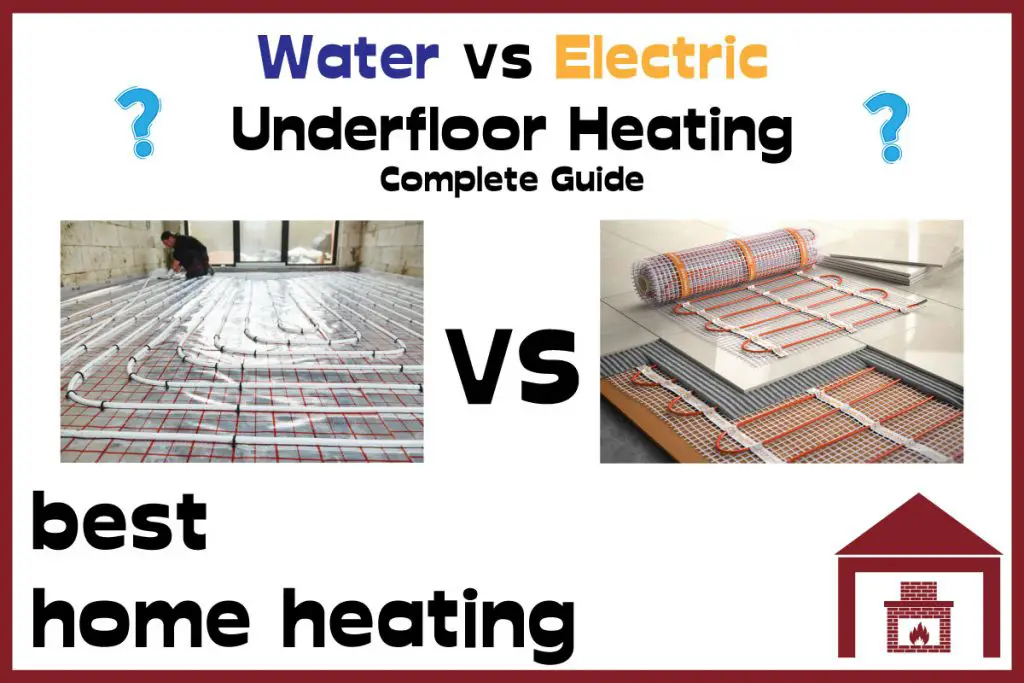
Overview – Water vs Electric Underfloor Heating
In water-based underfloor heating, heated water (35°C-55°C) is circulated through a series of pipes laid into the floor. A heat pump or central boiler serves as the source. Separate circuits are used in different zones. Water-based underfloor heating is known for its ability to distribute heat evenly throughout the property.
Electric underfloor heating systems, in contrast, involve installing thin heated wires under the floor. When the system is on, the wires heat up, providing radiant heat. Electric underfloor heating is more suitable for warming up smaller areas within your property.
Both water and electric underfloor heating use radiant heat. However, these two types of systems differ in many ways. Below, we are going to shed light on those differences.
Pros and Cons of Underfloor Heating
Water and electric underfloor heating systems have their advantages and disadvantages. In the table below, we are going to show the most notable pros and cons of these two options:
| Types of Underfloor Heating Systems | Pros | Cons |
| Water | Low running costs. Highly compatible with heat pumps. Suitable for large spaces. High efficiency with an increase in runtime. | High installation costs. Complex process of installation. Requires space for pipes Slow to warm up. Difficult to repair in an event of a fault. Increases floor height. |
| Electric | Lower upfront costs. Quick to warm up. Quick and easy installation. Easy to fix in an event of a fault. Adds little to no height to the floor. | High running costs. Not suitable for all floor coverings. Does not preserve heat. |
Applications of each type of Underfloor Heating
Water Underfloor Heating
In principle, water underfloor heating can be installed in any room. In practice, it is used mostly in living rooms. The reason is that water pipework infrastructure takes up some space, and the installation process can be a hassle in some places. Moreover, water underfloor heating is adequately efficient only in well-insulated rooms.

Electric Underfloor Heating
Electric underfloor heating is particularly suitable for heating rooms with fairly hard floors, such as kitchens and bathrooms. It is used in kitchens and bedrooms because it can be used to maneuver furniture and fixed units there – since underfloor heating should not be placed directly under these fixed units.
(See why) Electric underfloor heating is also installed in rooms that do not have enough space for radiators. If you need to heat a room quickly, electric underfloor heating is more suitable than water underfloor heating.
Check out this article all about upstairs underfloor heating, which talks about the use of different types of underfloor heating in different rooms on and different floors.
Costs and efficiency
Water Underfloor Heating
In a wet underfloor heating system, water that runs through the pipes is heated to a temperature of 35-55°C only. This range of temperature is significantly lower than that of conventional radiators (60°C or more).
Wet underfloor heating is highly efficient. When paired with a condensing boiler, it is about 25% more efficient than radiators. And the system is about 40% more efficient than radiators when paired with a ground source or air source heat pump. For a 10m² room, the annual running cost of a wet underfloor heating system is around $60.
Electric Underfloor Heating
Compared to water-based underfloor heating, electric underfloor heating is 3 to 4 times more expensive to run. This is mainly because electricity is more expensive than natural gas. Due to the high running costs, electric underfloor heating is not typically used to heat large spaces. If you are thinking of investing in underfloor heating to heat your entire property, electric underfloor heating is a bad option for you. If you want to heat a 10m² room with electric underfloor heating, you will have to spend about $290 annually.
The table below shows a detailed breakdown of the running cost for the energy consumed by electric underfloor heating systems, based on the Thermonet EZ 150W/m² system and the average electricity 2021 price tariff at 18.9p/kWh
| No of Days | Energy Consumed for a 150W heating mat 8 hrs. daily, for a 10m2 space. (KWh) | Price (£) (Tariff @18.9p/KWh) |
| 1 | 12 | 2.27 |
| 5 | 60 | 11.34 |
| 10 | 120 | 22.68 |
| 30 | 360 | 68.04 |
| 180 | 2160 | 408.2 |
| 365 | 4380 | 827.8 |

Costs of Installation
Water Underfloor heating
Installing a water-based underfloor heating system is usually expensive because the process involves preparing floors and screed layers. To get the system installed and connected to a boiler, you will have to hire a plumber. To enable the system to handle the additional load, you may have to upgrade your existing boiler.
For water underfloor heating, the initial cost of installation is higher than that of electric underfloor heating. However, the former has significantly lower running costs.
Electric Underfloor heating
Electric underfloor heating is significantly cheaper to install, in part because the process is quick and easy. However, to get the unit connected to the heat source, you still need the help of a qualified electrician.
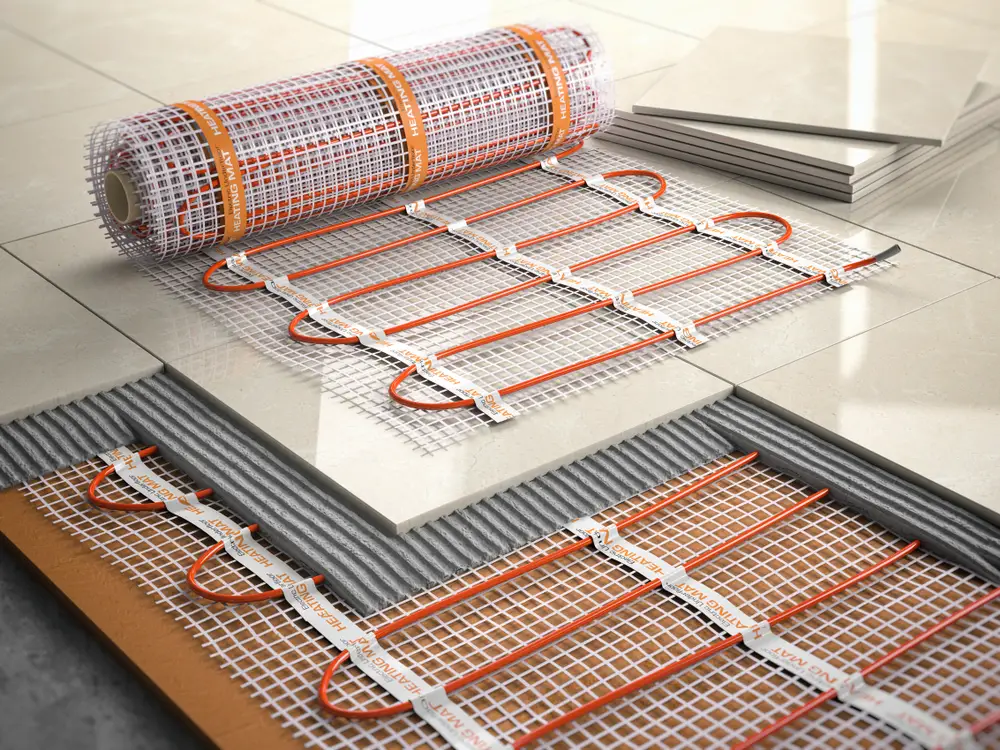
Retrofitting in an Old House vs. Installation in a New Build
The suitability of these underfloor heating systems also varies significantly for housing applications. Water and electric underfloor heating both have their applications where they fit easily; more on this below.
Water Underfloor Heating
Wet underfloor heating is more suited to new build projects. During the building process, it is easier to connect a water underfloor heating system to the boiler and water tank. If the building project has already been completed and everything is in place, setting up wet underfloor heating can be a hassle.
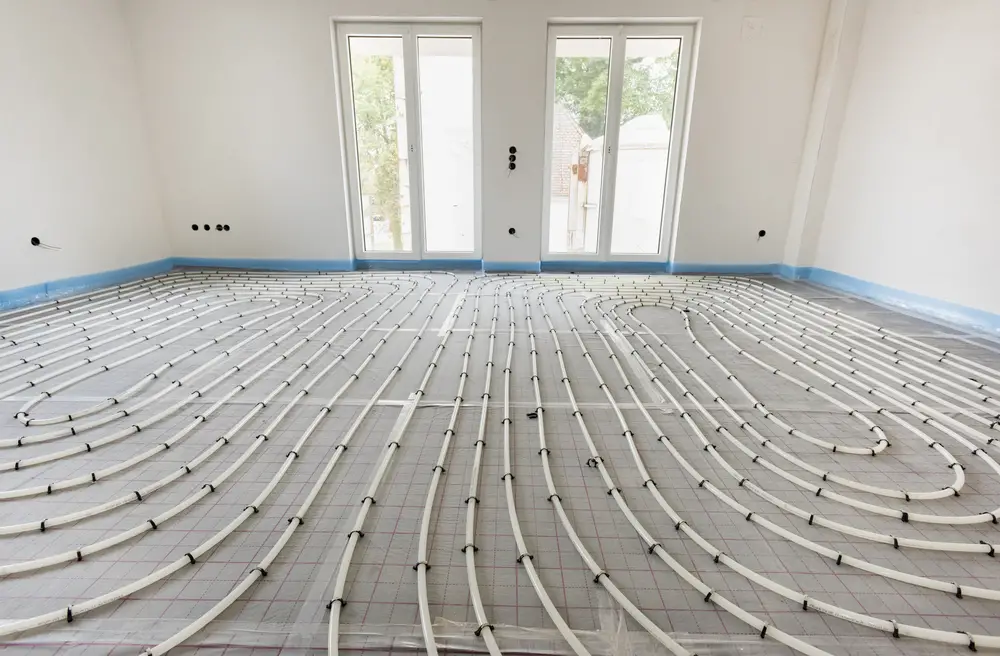
Electric Underfloor Heating
Electric systems are more suited to renovation projects. It has almost no effect on the floor build-up and does not add to the floor height. The heating cables can be easily fitted within a leveling compound. If you want to get a heating system installed in just one or two rooms, an electric system is preferable.
Lifespan of Underfloor Heating Systems
Water Underfloor Heating
Regular maintenance is needed for the smooth operation of wet underfloor heating. The pipes used for water-based underfloor heating last around 50 years. However, under certain circumstances, they can last over a century.
However, other faults can occur in wet underfloor heating, and they can be expensive to repair. These faults include pipe damage, pressure unit damage, wear and tear of the heating unit, and air bubbles in the pipes, which can damage the heat pump connected to the underfloor heating.
Electric Underfloor Heating
If the flooring remains intact, an electric underfloor heating system lasts over 25 years. This is the expected lifespan if a heat pump is used as a heat source. But if the Electric underfloor heating uses a traditional heat source such as a gas boiler, the system will last approximately 10 years because many components will need to be replaced over the years.
The bottom line is, that a water underfloor system lasts longer than electric underfloor heating.

Depth and layers
Water Underfloor Heating – If a liquid screed is used, the minimum depth of a water underfloor heating system should be 50mm. In case a hand-mixed screed is used, the depth should be at least 65mm. This is because, in the screed, the heating pipes are completely submerged. In a hand-mixed screed, a considerable amount of air gets trapped. In liquid screed, this volume is nominal.
The layers of wet underfloor heating depend on the type of floor. On average, there are 9 layers for a water underfloor heating system. From bottom to top, they are as follows: subfloor, damp proof membrane, rigid insulation, warmup perimeter expansion strip, warmup 16 mm pipework, warmup nexxa panel, 65-75 mm sand & cement screed, flexible tile adhesive, and tile floor finish.
Electric Underfloor Heating– It’s a slim option. The depth of an electric underfloor heating system is less than that of a water-based system. In general, an electric underfloor heating system adds around 10 mm in thickness to the floor.
The process of installing electric underfloor heating involves installing multiple layers that include subfloor, damp-proof membrane, timber battens, warmup coated insulation, warmup loose wire, warmup tape, leveling compound, and wood flooring. The number of layers can be more or less depending on the floor type.

Water Underfloor Heating Layers
The table below shows the layers of materials for a water underfloor heating system :
| Layer Count | Tiled Floor | Laminate Floor(Floating) | Laminate Floor(Glued) | Vinyl Floor(Floating) | Vinyl Floor(Glued) | Carpet Floor |
| 1 | Subfloor | Subfloor | Subfloor | Subfloor | Subfloor | Subfloor |
| 2 | Damp proof Membrane | Damp proof Membrane | Damp proof Membrane | Damp proof Membrane | Damp proof Membrane | Damp proof Membrane |
| 3 | Rigid Insulation | Rigid Insulation | Rigid Insulation | Rigid Insulation | Rigid Insulation | Rigid Insulation |
| 4 | Warmup perimeter expansion strip | Warmup perimeter expansion strip | Warmup perimeter expansion strip | Warmup perimeter expansion strip | Warmup perimeter expansion strip | Warmup perimeter expansion strip |
| 5 | Warmup 16 mm pipework | Warmup 16 mm pipework | Warmup 16 mm pipework | Warmup 16 mm pipework | Warmup 16 mm pipework | Warmup 16 mm pipework |
| 6 | Warmup Nexxa Panel | Warmup Nexxa Panel | Warmup Nexxa Panel | Warmup Nexxa Panel | Warmup Nexxa Panel | Warmup Nexxa Panel |
| 7 | 65-75 mm sand & cement screed or proprietary screed | 65-75 mm sand & cement screed or proprietary screed | 65-75 mm sand & cement screed or proprietary screed | 65-75 mm sand & cement screed or proprietary screed | 65-75 mm sand & cement screed or proprietary screed | 65-75 mm sand & cement screed or proprietary screed |
| 8 | Flexible tile adhesive | Underfloor compatible underlay | Underfloor compatible timber floor adhesive | Underfloor compatible underlay | Underfloor compatible vinyl floor adhesive | Underfloor compatible underlay |
| 9 | Tiled floor finish | Floating timber floor finish | Timber floor finish | Floating vinyl floor finish | Vinyl floor finish | Carpet floor finish |
For more information concerning underfloor heating layers, visit here.

Electric Underfloor heating layers
The table below shows the layers of materials for an electric underfloor heating system:
| Layer Count | Warmup Loose cable system | Warmup Inscreed cable system(floating) | Warmup Foil system | Warmup loose wire, mat, or sticky-mat system | Warmup loose wire system(Wooden Subfloor) |
| 1 | Subfloor | Subfloor | Subfloor | Subfloor | Joisted Floor |
| 2 | Damp-proof membrane | Damp-proof membrane | Warmup Foil heater | Warmup flexible adhesive | Chipboard Deck |
| 3 | Timber Battens | Timber Battens | Warm insulated underlay | Warmup coated insulation | Damp proof membrane |
| 4 | Warmup coated insulation | Warmup coated insulation | Timber | Warmup sticky-mat | Timber Battens |
| 5 | Warmup loose wire | Warmup Inscreed rails | Leveling compound | Warmup coated insulation board | |
| 6 | Warmup Tape | Warmup Inscreed cable | Wood floor adhesive | Loose wire cable | |
| 7 | Leveling compound | 50mm screed | Wood flooring | Warming Tape | |
| 8 | Wood flooring | Wood flooring | Leveling compound | ||
| 9 | Wood Flooring |
Compatibility with other heat sources
Water Underfloor Heating
Underfloor heating is the best output mechanism for heat pumps, mainly due to their low-temperature flow. Water-based underfloor heating works very well with both ground source and air source heat pumps. People who invest in heat pumps almost exclusively use water-based underfloor heating rather than radiators or electric underfloor heating.
Electric Underfloor Heating
Electric underfloor heating uses electricity rather than hot water to heat the floors and therefore does not work with heat pumps. Unlike wet underfloor heating which takes up to 3 hours to warm up sufficiently, electric underfloor heating is a quick system that heats your place within a few minutes. It requires a 230 VAC supply.
Common problems of Water and Electric Underfloor Heating
Water Underfloor Heating
Several things can go wrong with a wet underfloor heating system, and due to these faults, the system may stop working, or work intermittently. Air bubbles in the pipes can be responsible for cold spots throughout your home. A continuous gurgling sound is a sign that there are air bubbles in the pipes.
A rapid temperature drop can make a wet underfloor system less effective. It is not designed for very cold temperatures. There is another problem with water underfloor heating systems: the failure of the actuator. When that happens, the heating zone won’t heat up as expected, and the system won’t turn off. This problem occurs when the thermostat has electrical issues.
Check out my dedicated articles all about noisy and patchy underfloor heating too.

Electric Underfloor Heating
An electric underfloor heating system also has its vulnerabilities. To regulate the output temperature, a thermostat is used. By using a sophisticated control system such as a smart thermostat, you can tell if the heat mats are working as expected.
Short-circuiting is a common issue for an electric underfloor heating system. As the system wears out and the wires break, short-circuiting occurs. And due to this issue, the system may fail. As an electric heating system ages, its cells get damaged. Each cell can be repaired separately, but at a point, replacing all the cells may be more convenient.
Some of these repairs can be carried out by the homeowner, you can visit here for more information on how these repairs are carried out. Although some repairs are best carried out by professionals, it’s best to call on them when in doubt.

Nonstop running vs. frequent on/off of Water and Electric Underfloor Heating
Water Underfloor Heating
In general, it’s a good idea to leave a wet underfloor heating system running nonstop, especially during the cold winter months. It is because the system is slow; it takes about three hours to sufficiently warm-up. Leaving the system running at low temperatures instead of switching it off results in faster warm-up times.
If your water underfloor heating is frequently turned on and off, it uses a lot of energy every time it starts. The system is a lot more energy-efficient if it is left running at low temperatures at all times. There is a disadvantage of leaving a wet underfloor heating system on at all times. The constant operation will negatively affect the lifespan of the heating system. This is not a big problem if the temperatures are regulated by a smart thermostat.

Electric Underfloor Heating
Electric underfloor heating is a fast system. It heats up quickly, within a few minutes, so you don’t need to keep the system on at all times. Switch it on only when needed. To ensure your home is always comfortably warm, use a smart thermostat.
Keeping an electric underfloor heating system constantly on is not only expensive but also bad for the system itself. The electric panels are not designed to run nonstop. So, if you use an electric system the way you use a wet system, chances are that the electric panels will wear out pretty quickly. Other implications of running these systems non-stop have been stated here.
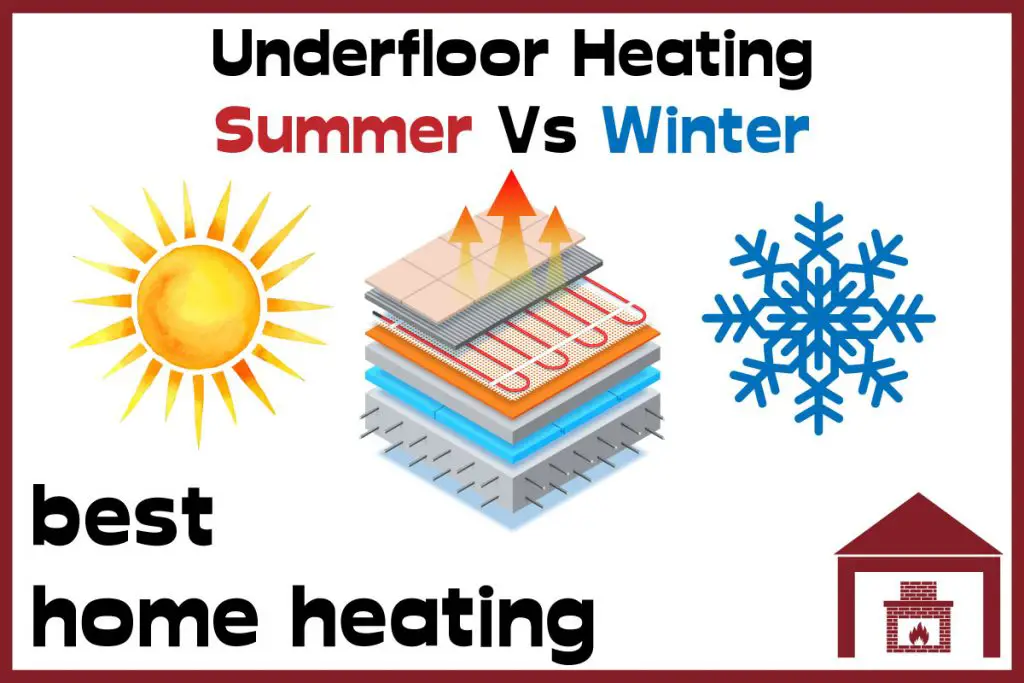
Compatibility of Underfloor Heating with smart thermostats
Water Underfloor Heating
Wet underfloor heating systems are compatible with smart thermostats. With a smart thermostat, you can remotely control your underfloor heating system. In general, this controlling device is a part of a cutting-edge hydronic underfloor heating system. If there are multiple zones, a separate smart thermostat is needed for each zone. See besthomeheating.com for more information on smart thermostats.
Electric Underfloor Heating
Thermostats control electric underfloor heating systems with the help of a feature called a heat link. Multiple thermostats may be needed to control a multi-zone or dual-fuel heating system. This setup, however, doesn’t work for bathrooms or areas with high humidity levels. A wet area needs a floor probe for the setup to work.
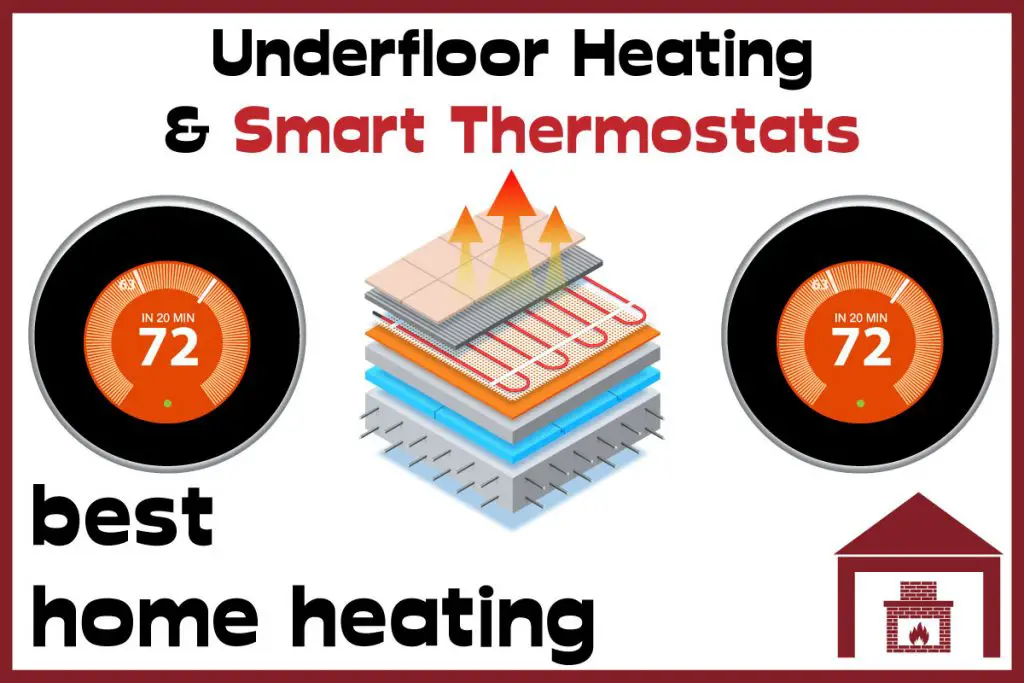
Safety, Fire risk, the likelihood of Leaks or Damage to a Home
Water Underfloor Heating– Water-based systems are suitable for homes that are still being built. Hot water runs via pipes laid throughout the floor. The pipes are connected to a central boiler, heat pump, or solar water heating system.
If all plumbing work is done professionally, there is very little risk of a leak. . The system will lose pressure in case of a leak. A damp area is a clear sign that there is a leak. If it is subtle, an infrared camera can be used to detect the exact location of the damage. Also, a pressure test can be carried out on the system, more on that here.
Non-professional installation is the main factor responsible for a possible hazard. Underfloor heating should not be turned on just after the installation has been done. Wait until all adhesives have dried. Special care should be taken when insulating the underfloor because a break can result from the absence of insulation.
Electric Underfloor Heating– If professionally installed, electric underfloor heating is safe. During installation, it is important to make sure that the wire in the mesh is not cut short. If you are installing the system in an old house, check the existing circuitry and make sure it has the capacity for taking the load. If the existing circuitry has worn out, install new fuses and wiring.
Electric Underfloor heating has been designed with safety features in mind. The wires come with a coating of PVC or fluoropolymer, so the cables are very unlikely to get damaged by the environment. The system is also equipped with a circuit breaker that cuts the power automatically whenever a fault is detected.

Flooring choices for Water and Electric Underfloor Heating
Water Underfloor Heating–
A water underfloor heating system requires enough space underneath the floor for the pipework. In most cases, the process requires elevating the floor level. Stone and tiles (such as slate, granite, ceramic, porcelain, and polished concrete), engineered wood, laminate, vinyl, and thin carpet are some good flooring options for water-based underfloor heating.
Ceramic and porcelain are the best options. Incorrect installation, cracked substrate, tiling over control joints, low-quality tiles, and hard impacts can lead to the cracking of tiles, but that likelihood can be significantly reduced by getting the tiles installed by professionals.
Electric Underfloor Heating
An electric underfloor heating system is easier to install, in part because the system is very slim. It consists of multiple sheets, mats, and cables, and the flooring choices are pretty much the same as a wet system. Solid wood flooring, cork, and thick pile carpets do not work very well with electric underfloor heating.
Advantages and Disadvantages of Underfloor Heating vs Radiators
As heat emitters, radiators have enjoyed popularity for a pretty long time. With the emergence of underfloor heating, radiators have become a less popular option for heating large spaces. But they have their uses, and in some cases, they are even more suitable than underfloor heating. In the table below, we are going to show the major pros and cons of underfloor heating and radiators.
| Heat Emitters | Pros | Cons |
| Underfloor Heating | Works very well with heat pumps. Even distribution of heat. Better air quality. Up to 25% more efficient than radiators | Installation is expensive. Slow to warm up. |
| Radiators | Newer models are better than older ones in terms of energy efficiency. Quick and easy installation. Suitable for any floor finish. | Heat distribution is uneven. Does not work well with heat pumps. Higher running costs |
Can underfloor heating replace radiators?
When considering installing an underfloor heating system it should be noted that several advantages must be considered. Such as lower heating costs owing to targeted heating, or more controlled heating of the whole house. Many homeowners find themselves wondering if they can replace their radiators with underfloor heating.
Underfloor heating that has been installed properly can easily replace radiators once the home has been insulated properly. Many homeowners that have gone the extra mile when installing their underfloor heating experience lower monthly costs to keep their homes heated.
This is because a fully installed underfloor heating system can heat rooms much more evenly. Allowing for the heat to spread throughout the home faster and more effectively, allowing homeowners to run the heating system at a lower temperature.
Conclusion – Water vs Electric Underfloor Heating – Who should choose which type?
If your house is just being built and you want to use underfloor heating as the primary source of heat, consider investing in a water-based underfloor heating system. It’s a good choice if you are planning to get a geothermal or air source heat pump and reduce your carbon footprint.
And if you need an underfloor heating system in an old house, an electric system is the right choice for you. It is because you may not want to reconstruct the floor just to fit the underfloor heating system in. You may not want to use your electric underfloor system throughout the home because that will be too expensive.
| Types of Underfloor Heating Systems | Pros | Cons |
| Water | Low running costs. Highly compatible with heat pumps. Suitable for large spaces. High efficiency with an increase in runtime. | High installation costs. Complex process of installation. Requires space for pipes Slow to warm up. Difficult to repair in an event of a fault. Increases floor height. |
| Electric | Lower upfront costs. Quick to warm up. Quick and easy installation. Easy to fix in an event of a fault. Adds little to no height to the floor. | High running costs. Not suitable for all floor coverings. Does not preserve heat. |
Invest in an underfloor heating system that will meet your particular needs. Consider discussing your project with an expert. A reliable provider can assess your heating needs, help you make informed decisions, and walk you through the whole process.
Lots more Underfloor Heating Information Here
- What Depth is Required for Underfloor Heating?
- Turning on Underfloor Heating for the First Time – How Long to Wait?
- Can you lay Vinyl flooring over underfloor heating?
- Do Tiles Crack With Underfloor Heating?
- Can You Heat a Whole House With Underfloor Heating?
- Can You Have Underfloor Heating Upstairs?
- Will Underfloor Heating Raise My Floor? – Underfloor Heating Layers Explained
- Can I put furniture on top of underfloor heating?
- How Do I Know If My Underfloor Heating is Leaking?
- Can You Combine Underfloor Heating With a Ground Source Heat Pump?
- Is Underfloor Heating Safe?
- Does Underfloor Heating Add Value to a Property?
- Can you have Wooden Floors with Underfloor Heating?
- Can Underfloor Heating Cause a Fire?
- What temperature should Underfloor Heating be set at?
- Can I Put a Rug Over Underfloor Heating?
- How Long Does it Take for Underfloor Heating to Warm Up?
- Why is my Underfloor Heating Noisy?
- Why is my Underfloor Heating Patchy?
- How do I know if My Underfloor Heating is Working? – Common Problems & Fixes
- What can go wrong with underfloor heating?
- Can you Combine Underfloor Heating with an Air Source Heat Pump?
- Do you keep underfloor heating on all the time?
- Does Underfloor Heating work with Smart Thermostats?
- Kitchen Underfloor Heating – Should Underfloor Heating go Under Kitchen Units?
- How much energy does Underfloor Heating use?
- Underfloor Heating in Summer and Winter
- Lifespan of Underfloor Heating




